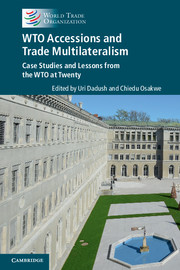Book contents
- Frontmatter
- Dedication
- Contents
- List of contributors
- Foreword
- Acknowledgements
- List of abbreviations
- Editors' note
- PART I WTO accessions, the trading system and the global economy
- PART II Overview: systemic outcomes from accessions
- PART III Members’ perspectives on accession negotiations
- PART IV Working party chairpersons’ perspectives on accession negotiations
- PART V Salient features inWTOAccession Protocols
- 29 Market access goods negotiations: salience, results and meaning
- 30 Services market opening: salience, results and meaning
- 31 WTO accession and the private sector: the nexus of rules and market opportunities
- 32 WTO accession and accession to the Agreement on Government Procurement: what is the relationship? Why should WTO acceding governments also consider GPA accession?
- 33 Energy-related rules in Accession Protocols: where are they?
- 34 Domestic framework for making and enforcing policies
- 35 Export duty commitments: the treaty dialogue and the pattern of commitments
- 36 Disciplining state trading practices: lessons from WTO accession negotiations
- 37 Intellectual property rights protection: the plus/minus debate from a least-developed country perspective – sense and nonsense
- 38 The future of multilateral investment rules in the WTO: contributions from WTO accession outcomes
- 39 Sanitary and phytosanitary measures: trends in accession plurilateral negotiations
- 40 Strengthening transparency in the multilateral trading system: the contribution of the WTO accession process
- PART VI Conclusion
- Annex: Contributor biographies
- Index
- Plate section
- References
35 - Export duty commitments: the treaty dialogue and the pattern of commitments
from PART V - Salient features inWTOAccession Protocols
Published online by Cambridge University Press: 05 November 2015
- Frontmatter
- Dedication
- Contents
- List of contributors
- Foreword
- Acknowledgements
- List of abbreviations
- Editors' note
- PART I WTO accessions, the trading system and the global economy
- PART II Overview: systemic outcomes from accessions
- PART III Members’ perspectives on accession negotiations
- PART IV Working party chairpersons’ perspectives on accession negotiations
- PART V Salient features inWTOAccession Protocols
- 29 Market access goods negotiations: salience, results and meaning
- 30 Services market opening: salience, results and meaning
- 31 WTO accession and the private sector: the nexus of rules and market opportunities
- 32 WTO accession and accession to the Agreement on Government Procurement: what is the relationship? Why should WTO acceding governments also consider GPA accession?
- 33 Energy-related rules in Accession Protocols: where are they?
- 34 Domestic framework for making and enforcing policies
- 35 Export duty commitments: the treaty dialogue and the pattern of commitments
- 36 Disciplining state trading practices: lessons from WTO accession negotiations
- 37 Intellectual property rights protection: the plus/minus debate from a least-developed country perspective – sense and nonsense
- 38 The future of multilateral investment rules in the WTO: contributions from WTO accession outcomes
- 39 Sanitary and phytosanitary measures: trends in accession plurilateral negotiations
- 40 Strengthening transparency in the multilateral trading system: the contribution of the WTO accession process
- PART VI Conclusion
- Annex: Contributor biographies
- Index
- Plate section
- References
Summary
ABSTRACT
This chapter focuses, pursuant to Article XII accession-specific commitments, on the evolving disciplines on export duties, distinguished from the broader setting of export restrictions. From a rules angle, export duties were not subject to disciplines, in contrast to import duties that have, classically, been bound in schedules of concessions and commitments on goods since GATT 1947. Pursuant to Article XI:1 of the General Agreement on Tariffs and Trade (GATT) 1994 (rules for ‘quantitative restrictions’), prohibitions or restrictions on imports and exports, such as bans, quotas and restrictive licences, are generally prohibited, except for duties, taxes or other charges. In economic operations, export duties with price discrimination effects between domestic and foreign producers have resulted in efficiency losses and anti-competitiveness, and have undermined economic welfare. In accession negotiations, the establishment of disciplines and improvement in economic welfare has framed the treaty dialogue. This dialogue has made evident a range of issues that are systemic and that have involved questions on international economic cooperation, revolving around the broader use of export restrictions and their overlap with export duties. This chapter reviews the substance of the treaty dialogue on export duties and identifies the extent and pattern of specific obligations on export duties in the Article XII Accession Protocols deposited thus far. The analysis shows that fifteen Article XII members have accepted accession-specific obligations on the application of export duties. These obligations range across ‘abiding’ by the provisions of the WTO Agreement; ‘binding and/or fixing’ applied export duty rates; and, ‘reducing’, ‘eliminating’ or ‘foreclosing’ on the use of such duties. Of precedential value is the modification of the classical 1947 architecture of the GATT Goods Schedule to create a Part V on Export Duties in the context of the WTO accession commitments of Russia in its Goods Schedule. This chapter argues that accession-specific commitments have deepened and extended original WTO rules governing export duties as an instrument of trade policy. The overall systemic effect has been positive, namely to constrain, reduce, eliminate and/or bind, hence contributing to clarity and predictability of the rules with pro-competitive effects, enhancement of market access opportunities and improvements in economic welfare. The chapter argues that WTO accession-specific obligations for export duties have set the multilateral standard for disciplines in this area.
- Type
- Chapter
- Information
- WTO Accessions and Trade MultilateralismCase Studies and Lessons from the WTO at Twenty, pp. 741 - 763Publisher: Cambridge University PressPrint publication year: 2015



